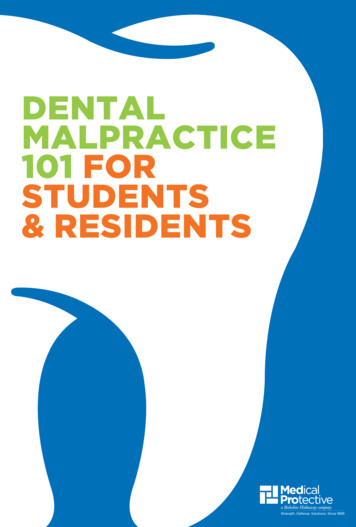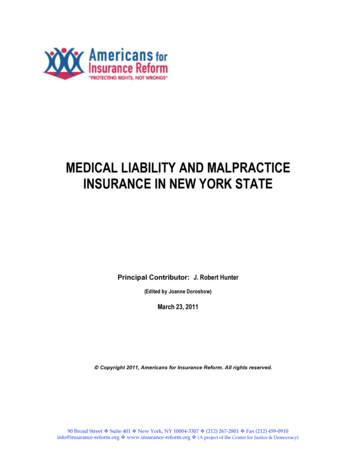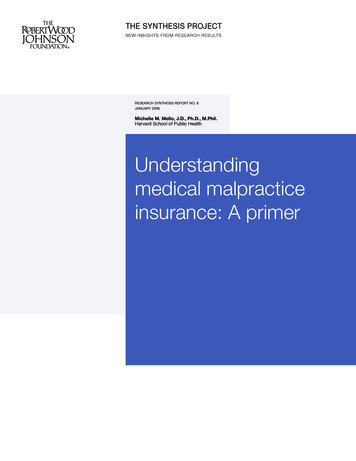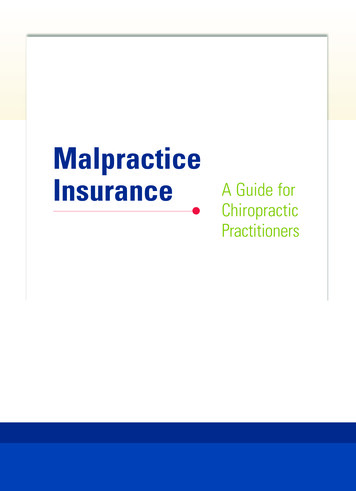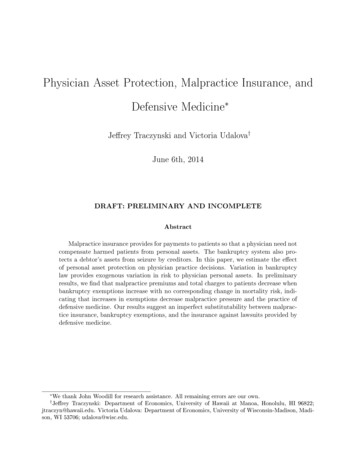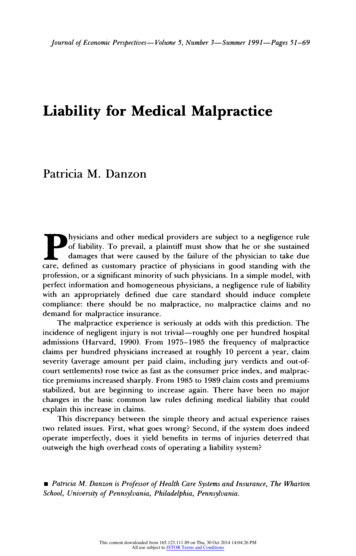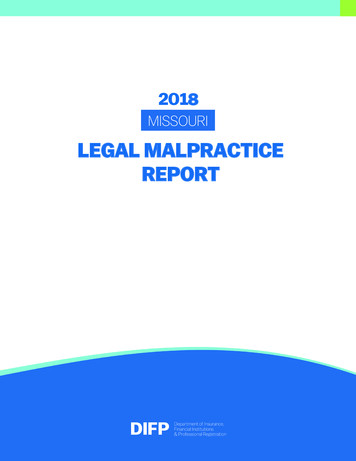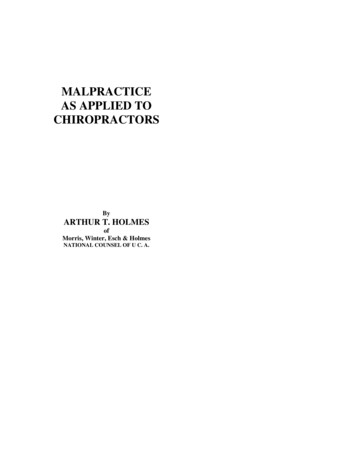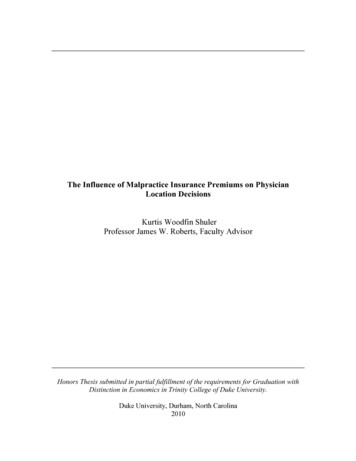
Transcription
The Influence of Malpractice Insurance Premiums on PhysicianLocation DecisionsKurtis Woodfin ShulerProfessor James W. Roberts, Faculty AdvisorHonors Thesis submitted in partial fulfillment of the requirements for Graduation withDistinction in Economics in Trinity College of Duke University.Duke University, Durham, North Carolina2010
AcknowledgmentsI would like to express my very sincere thanks to my faculty advisor, Professor James W.Roberts for his help on this project. His advice and criticism has proven indispensable. Iwould also like to thank my classmates for their feedback throughout the semester, and ofcourse, my honors seminar professor, Dr. Michelle Connolly, for all of the insight she hasprovided me. Without her encouragement and support, this project would not have beenpossible.2
AbstractExisting economic literature has suggested that areas that implement caps limitingnoneconomic damages in malpractice lawsuits experience a greater increase in physiciansupply than areas that do not have noneconomic damage caps. It has been proposed thatnoneconomic damage caps achieve this effect by reducing malpractice premiums.Specifically, noneconomic damage caps are presumed to reduce malpractice premiumseither by reducing the number of malpractice claims filed, or by reducing the size ofpayouts for malpractice claims. I find that physicians do respond to malpractice rateswhen choosing where to practice, but that noneconomic damage caps do not appear tosignificantly reduce malpractice premiums and thus have minimal indirect impact onphysician supply in an area.3
Introduction:This study investigates whether the cost of malpractice insurancepremiums affects where physicians decide to practice and if malpractice noneconomicdamage caps induce growth in physician supply via reduced insurance premiums.Healthcare patients in the United States who are injured through negligentpractice can seek restitution through medical malpractice suits. Generally, these suits fallunder a body of civil law called torts, which cover wrongs that do not involve anycontractual relationship. The legislation covering malpractice torts varies among states,but in general these laws are designed to provide victim compensation and deter medicalmalpractice. Most states require that healthcare providers purchase professional liabilityinsurance to protect themselves from malpractice claims (Mello, 2006).Becausemalpractice premiums may be an important factor affecting physician income, the priceof professional liability insurance may have a strong effect on the location wherephysicians choose to practice.Consequently, tort laws that influence the price ofmalpractice insurance may have an indirect influence on physician supply in geographicareas for which they apply. I attempt to quantify this impact by analyzing changes inphysician supply and malpractice insurance premiums in states that have enacted tortreforms as compared to states that did not have tort reforms in place from 1996 to 2006.In an economic sense, the extent to which tort reform will increase thesupply of physicians will depend on three factors: 1) physicians’ sensitivity to changes in4
income; 2) the extent to which malpractice premiums affect physicians’ income; and 3)the degree to which tort laws affect malpractice premiums. Physicians have sought toreduce their malpractice premiums in a number of ways. While individual practitionerstypically purchase malpractice insurance out-of-pocket, hospitals often purchase policiesthat cover their medical staff (Mello, 2006). Because larger institutions have moreleverage in negotiating insurance rates than individual practitioners, physicians may seekto align more closely with hospitals in an effort to seek affordable insurance (Mello,2006). Physicians’ income is only indirectly affected by changes in insurance premiumswhen hospitals buy their malpractice insurance, which may reduce their sensitivity to ratechanges. Moreover, an increasing number of hospitals have opted to self-insure in aneffort to avoid insurance rate increases. Similarly, there has been significant growth inphysician owned and operated insurance companies (Hillman & Cluff, 2003). Thesenon-profit, physician owned companies may be able to offer better rates because of asuperior knowledge of the practicing physicians in the market (Hillman & Cluff, 2003).Furthermore, because the physicians themselves own the companies, they may have moremotivation to try and prevent malpractice claims. If these measures successfully reducethe prices doctors pay for malpractice insurance, they may diminish the effects of tortreform on physician supply. Beyond economic factors, it is important to consider thattort reforms may offer psychological incentives for physicians to practice in certaingeographic areas as well, such as peace of mind about awards beyond what theirinsurance policy covers, and reduced stress over having to go through a litigationprocedure.5
Malpractice insurance premiums and their growth rates vary widely bothgeographically and by medical specialty. Differing legal environments are likely onesource of this variation.Awards from malpractice suits usually consist of severalelements, including punitive damages, economic damages (lost wages, medical bills, andlegal fees), and noneconomic damages (physical pain, emotional distress, loss ofenjoyment of life, physical impairment). Awards associated with these elements aresubject to individual regulations that vary by state. Consequently, state specific tort lawsmay affect the size and frequency of malpractice claims.Malpractice claims are a major cost faced by insurers providingprofessional liability insurance for physicians. Thus, it is expected that the monetaryvalue and frequency of these claims are likely important determinants of the price ofmalpractice insurance, and that tort reforms that make it more difficult to file malpracticeclaims or that limit the size of malpractice awards may reduce premiums. Additionally,tort reforms that limit damage awards may further reduce premiums by enabling insurersto better predict potential payouts (Hillman & Cluff, 2003).If insurers demandcompensation for greater payout uncertainty, the cost will likely be at least partiallypassed on to physicians purchasing insurance.Tort reform advocates maintain that an increasing frequency ofmalpractice claims, along with larger jury awards and settlements, are major contributingfactors to the rising cost of medical care. Citing anecdotal reports of work stoppages andphysicians relocating to regions with lower insurance premiums, they argue that the price6
of liability insurance has now reached levels that are seriously threatening patients’access to health care. In particular, malpractice premiums for high-risk specialties likegeneral surgeons and gynecologists increased rapidly in the early part of this decade(DiRosa, Brennan, D'Souza, Houchins-Witt, & Smith, 2003). Proponents of tort reformsuggest that legislation limiting malpractice claims and settlements ultimately leads tocheaper, more accessible health care.If tort reforms successfully reduce malpracticeinsurance, their impact on physician income will depend on the elasticity of health caredemand. If demand is relatively elastic, physicians will be unable to pass on their costs toconsumers, and tort reforms that affect malpractice premiums may influence thegeographic distribution of physicians. Conversely, many economists believe that becauseinsurance reduces the marginal costs of health care services, demand will likely be fairlyinelastic (Baicker & Chandra, 2005). If this is the case, physicians will be able to pass onadditional insurance costs to consumers, and tort reforms will have little effect on wherephysicians choose to practice.Meanwhile, opponents contend that insurance companies’ poor investmentdecisions, rather than an increase in award sizes or a greater frequency of malpracticeclaims, have led to the rapid increase in insurance premiums. In particular, decliningbond revenues between 1998 and 2001 may have been passed on to physicians in theform of higher premiums (Baicker & Chandra, 2005). According to the ConsumerFederation of America, the average payment from malpractice cases has remainedconstant over the last decade (Hellinger & Encinosa, 2003).Furthermore, stateregulations require that malpractice insurance premiums are set in consideration of7
expected investment return (Hillman & Cluff, 2003). Accordingly, opponents of tortreform claim that high returns during the 1990’s allowed insurers to keep rates artificiallylow, and that the sharp increases in malpractice premium rates at the turn of the centurywere simply a market adjustment.Rather than improving access to medical care,opponents maintain that damage caps only serve to hurt those patients who are most inthe most need (Hellinger & Encinosa, 2003). In particular, these opponents suggest thatlow-income patients whose payouts mainly consist of noneconomic damages will be hurtby tort reforms, and that those victims may find that they are unable to find a lawyer totake their case.Regardless of the cause, rising rates have certainly prompted physicians tocall for tort reforms that limit malpractice damages. The American Medical Association(AMA) has argued that one of the major determinants of professional liability insurancerates is the size of malpractice awards and that over time insurance will be cheaper inthose states which have enacted effective caps on awards in medical malpractice cases(Hellinger & Encinosa, 2003).Moreover, widespread public sentiment that manymalpractice cases are filed by greedy people trying to take advantage of the system ratherthan those who were legitimately injured has solidified support for legislation which putscaps on malpractice damages.Existing research using OLS regressions by the Agency for Healthcare andResearch Quality (AHRQ) has suggested that states that have enacted caps limitingmalpractice awards have experienced a higher per capita growth rate of physicians than8
states that have enacted no such reform. The AHRQ proposes that states with capslimiting malpractices awards generally have lower malpractice insurance premiums,leading to a shift in the geographic distribution of physicians. Citing existing work in1978 by Michael Intrilligator and Barbara Kehner, the AHRQ suggests that state specificstatutes that determine the legal conditions of malpractice cases have a significant impactboth on the size of malpractice awards and the frequency of claims.As a result,physicians are drawn to practice in states that have enacted tort reforms to limitmalpractice awards. The AHRQ’s research looks only at the relationship between stateswith caps versus states without caps limiting malpractice awards, and it does not directlyinvestigate the impact of malpractice premiums on the growth rate of practicingphysicians (Hellinger & Encinosa, 2003).I extend the AHRQ’s research by incorporating data from the MedicalLiability Monitor, which has information about medical liability insurance rates by stateand territories within states for internal medicine, general surgery and OB/GYNspecialists. In addition to investigating the effects of noneconomic damage caps onphysician supply, I look directly at the impact of medical liability insurance rates on thephysician growth rate, and I find evidence that physicians do respond to changingmalpractice premiums when choosing where to practice.Furthermore, I examine hownoneconomic damage caps affect malpractice payouts and claims, and how the size ofmalpractice payouts and the frequency of malpractice claims affect medical malpracticepremiums. The AHRQ has proposed that noneconomic damage caps cause an increase inphysician supply by reducing insurance premiums.Their proposition is that9
noneconomic damage caps reduce the size of malpractice payouts and the frequency ofmalpractice claims, and that in a competitive market this leads to lower malpracticepremiums. Using evidence gathered in my investigation about noneconomic damagecaps and their effects, I analyze whether the AHRQ’s proposed mechanism describing theimpact of noneconomic damage caps is reasonable.Literature Review:The United States General Accounting Office (GAO) was commissionedto investigate health care providers’ responses to rising insurance premiums, becauseCongress was considering implementing nation wide tort reform. Their report, releasedin August 2003, examined how tort reform affected the price of malpractice insuranceand whether increasing premiums had adversely affected patients’ access to health care.The GAO examined growth in malpractice premiums and claims payments at a nationallevel. The GAO did not have access to national data about health care providers’responses to increases in insurance premiums and instead relied on data from five stateswith reported malpractice problems, such as physicians experiencing difficulty obtaininginsurance, higher than average premium growth rates, and accounts of actions taken byproviders due to malpractice concerns and increasing premiums (Florida, Nevada,Pennsylvania, Mississippi, and West Virginia). These five states were compared to fourstates that reportedly did not have high malpractice premium problems (California,Colorado, Minnesota, and Montana).10
The GAO confirmed anecdotal cases in the five states with reportedproblems where the growth of malpractice premiums had diminished patient access tohealth care services. These problems were particularly acute in rural areas, althoughsome providers suggested getting adequate care in rural areas was a persistent problemand not necessarily related to a decrease in available practitioners. The GAO also foundthat many of the reported cases could not be validated or did not significantly reduceaccess to health care services. Often, reports of physicians relocating or retiring wereuntrue or involved too few physicians to substantially affect health care access. Thesefindings were supported by a review of Medicare claims, which did not find anysignificant usage reduction of high-risk services like orthopedic surgeries ormammograms.The GAO found that there was evidence, although limited, suggesting thatnoneconomic damage caps reduced the growth of malpractice premiums. Specifically,premium growth rates throughout the 1990’s were slower for general surgery, internalmedicine, and OB/GYN specialists in states with noneconomic damage caps. Althoughthe GAO found that claims awards were lower for states with noneconomic damage caps,there was wide geographic variation along with variation across medical specialties.Furthermore, the GAO was unable to determine how much variation in premium levelscould be attributed to noneconomic damage caps versus other factors affecting premiumssuch as the insurer’s investment returns, other tort reforms, or the level competitionamong insurers.11
Interestingly, although the GAO found that access to health care was notgreatly affected by legislation limiting damage awards, the Agency for HealthcareResearch and Quality (AHRQ), which also released a report in 2003, found that statesthat had enacted noneconomic damage caps experienced a larger growth rate of per capitaphysicians. The authors used ordinary least squares to regress on dummy variablesindicating whether or not the state had enacted a cap limiting noneconomic damageawards along with a variety of other controls thought to affect where physicians choose topractice. Some of these factors included: Per capita income, unemployment rates,population density, proportion of elderly citizens, proportion of citizens working inagriculture, physician residency programs, HMO enrollment, and climate.According to the AHRQ’s analysis, states that had enacted noneconomicdamage caps experienced a 12% greater increase in physicians per capita than states thatdid not adopt noneconomic damage caps. A simple comparison showed that before capswere implemented the average number of physicians per 100,000 per county was 69 instates that eventually enacted caps versus 67 in states that did not enact caps. By year2000 these figures had changed to 135 per 100,000 in states with caps versus 120 per100,000 in states without caps.Their regression results showed that caps wereresponsible for 24 more physicians per 100,000 residents as compared to states without acap1. The analysis did not include any other laws that might affect physician locationdecisions.1Statistically significant at a 95% confidence level12
In a follow up study, the authors expanded their analysis to include yearsboth before and after the caps were implemented.Using a difference-in-differenceapproach, the authors sought to examine the effects of caps on physician supply both inurban and rural areas. Using a fixed effects model to control for county differences, theauthors regressed the log of physician supply on dummies indicating whether or not thestate had a cap during the given year. The authors concluded that most effects occurredthree or more years after the caps had been implemented, and that caps were responsiblefor a 2.18% increase in the supply of physicians within a county. Moreover, the authorsfound that noneconomic damage caps could increase the supply of surgeons andOB/GYNs in rural areas.While the existing literature suggests that noneconomic damage caps mayhave a beneficial effect on the supply of physicians, the mechanism for this increase inphysicians is not clear. One possibility is that noneconomic damage caps decreaseinsurance premiums over time, thus providing incentives for physicians to practice instates that have caps. Another possibility is that the number of claims is reduced becausenoneconomic damage caps diminish the potential gain from a lawsuit. Finally, if statesthat implemented noneconomic damage caps are also more likely to have implementedother tort reforms that affect size and frequency of claims, it is possible that the estimatedeffects of caps from prior research are suffering from omitted variable bias. If the actualeffects on physician supply resulted from these other reforms, the estimated effects ofnoneconomic damage caps may be inflated.13
My analysis regresses directly on malpractice insurance premiumsprovided by the Medical Liability Monitor (MLM). Additionally, I include data from theNational Practitioner Data Bank (NPDB) to help control for frequency of claims. Finally,I include controls for additional tort reforms to estimate how noneconomic damage capsaffect physician supply on a state specific basis.Theoretical Framework:The underlying theoretical framework of this analysis is that physicians tryto minimize their exposure to malpractice suits by locating in states where legislation ismore favorable. In particular, states with noneconomic damage caps should generallyhave lower premiums than states without noneconomic damage caps. The reason for thelower premiums is twofold. First, if insurance companies face lower payouts as a resultof noneconomic damage caps and the market for professional liability insurance iscompetitive, premium levels will fall accordingly. Second, the frequency of malpracticeclaims may be reduced through noneconomic damage caps since the potential payout forboth plaintiffs and lawyers is reduced.Lower insurance premiums and reducedfrequency of claims may both provide better incentives for physicians to practice in agiven area.The demand for health services likely also plays a role in the geographicdistribution of physicians. Areas with a higher proportion of insured citizens, higher percapita income, lower unemployment rates, and a larger proportion of older citizens areexpected to have a larger demand for physicians.14
Additionally, parameters typically identified in general migration modelswill likely be important factors in the flow of physicians.Moving costs, distance,expected income, and population effects are likely to play a role in physicians’ migrationdecisions (Kennan & Walker, 2003). It is anticipated that moving costs are likely higherfor physicians that are already established, and it may be more informative to look at thelocation decisions of new or younger physicians when evaluating the effects of tortreform. In addition to affecting demand conditions, population may have an effect onlocation decisions as a person is more likely to have a friend or relative in more populousareas (Kennan & Walker, 2003). Similarly, previously living in a certain area has strongeffect on migration decisions (Kennan & Walker, 2003). Consequently, home, school,and residency program locations will likely be important factors in determining wherephysicians choose to practice.Data:The data for this study comes from four sources. The first, the AreaResource File (ARF) is a national, county-level database containing information abouthealth facilities, health professions, economic activity, and health training programs. TheARF is a compilation of several sources including the AMA, the American HospitalAssociation, the US Census Bureau, Centers for Medicare and Medicaid Services, theBureau of Labor and Statistics, and the National Center for Health Statistics. The ARF isused to determine the number of practicing physicians in specific areas, as well as controlfor important demographic factors that may affect physician supply and vary withgeography such as employment levels, income levels, and health training facilities.15
The second data source, the National Practitioner Data Bank (NPDB) is aregistry maintained by the U.S. Department of Health and Human Services (NationalPractitioner Data Bank Public Use Data File, 2009). Medical malpractice payers arerequired to report payments to the NPDB under the Health Care Quality ImprovementAct of 1986 (Baicker & Chandra, 2005). The reliability of the NPDB has come underquestion by both the Physician Insurers Association of America (PIAA) and the GAO fora number of different reasons. First, the NPDB only includes information on claimspayments themselves, and not the administrative costs involved in settling a claim(Kessler, 2006).Second, the PIAA has charged that the NPDB has suffered fromunderreporting problems that have been growing over time (Kessler, 2006). According tothe GAO, the NPDB suffers from a “corporate shield” that exempts the inclusion ofpayments by hospitals and other corporations when individuals filing the claim removethe practitioner’s name from the claim, and instead name the hospital or corporation asresponsible (Redican-Bigott & Harris, 2000). Despite these shortcomings, the NPDB islikely the best estimate available for size and frequency of malpractice claims.The Medical Liability Monitor’s (MLM) rate survey is used to estimatemedical liability insurance rates. The MLM’s rate survey collects information aboutinsurance rates from major insurers across the United States. According to the MLM, therate survey represents between 65 to 75 percent of the medical liability insurance market(Karls, 2008). The survey reports rates by state and territories within states and byinsurer for internal medicine, general surgery and OB/GYN specialists. The rate surveyalso contains information about patient compensation funds (Karls, 2008).Patient16
compensation funds (PCFs) provide coverage for malpractice awards above a predefinedamount. PCFs are funded by surcharges on medical practitioners, thus PCFs have thepotential to affect both malpractice premiums and physicians’ income. The MLM’s ratesurvey is used to estimate the price of malpractice insurance across different regions, aswell as control for the existence of PCFs by adding the PCF surcharges to malpracticerates.The rate survey is not available in electronic format. I converted theMLM’s insurance rate estimates into an electronic format by hand-entering the insurancerate information for each of the three available medical specialties for the 3143 countiesin the US from 1996 to 2006. When rate information was not available at the countylevel, I used the U.S. Census Bureau’s historical Metropolitan and MicropolitanStatistical Areas for the appropriate year to cross-reference cities to their appropriatecounties.2 Not all insurance companies consistently report their rates in the MLM everyyear. To prevent trends in insurance premiums from being obfuscated by irregularreporting, one insurance company from each state was chosen to represent changingmalpractice premiums. The downside to this approach is that it does not fully representthe malpractice insurance market.Generally, however, the insurance rates for allcompanies represented in the MLM tend to move together, and selecting a singlecompany likely provides a good approximation.Company selection was based onwhether the company reported rates for the entire 1996-2006 year time span and howspecifically the company reported regional insurance rates.Companies with more2The US Census Bureau’s definitions from 1993 were used for years 1996 to 1998; definitions from 1999were used for years 1999 to 2006.17
specific reporting were preferred.Finally, information about noneconomic damage caps was gathered fromreports by the American Medical Association, the American Tort Reform Association,and the McCullough, Campbell & Lane LLP law firm ("Caps on Damages," 2008;McCullough, 2007; Noneconomic Damages Reform," 2007; Tort Reform Record,"2009). Tort reform information was gathered manually and hand entered for the 50 statesand the District of Columbia for the years 1991 to 2006.Empirical Specification:This investigation (if noneconomic damage caps induce growth inphysician supply through reducing malpractice premiums) comes in two parts. The firstpart investigates whether physicians do indeed respond to insurance premiums whenmaking decisions about where to practice.Furthermore, it looks at the effects ofnoneconomic damage caps both controlling for and not controlling for insurancepremiums to see if the apparent effects of noneconomic damage caps on physician supplyare mediated by insurance premiums as other researchers have suggested. The secondpart will look directly at how insurance premiums respond to noneconomic damage caps.Moreover, this second part looks at how noneconomic damage caps affect payouts andfrequency of malpractice claims because these are the main mechanisms suggested forhow noneconomic damage caps could affect malpractice premiums.18
The first part of this investigation uses the following fixed effects model toestimate the effects of tort reforms and insurance prices on physicians’ decisions aboutwhere to practice on the county level:Δlog((physicians 1)/population)it β0 β1 ΔInsurit β2 Cap300it β3 Cap600it β4 CapGr600it β5 Δlog(hospital admissions 1)it β6 Δ%Elderlyit β7 Δlog (Per capita income) it β8 ΔUnemploymentit β9 Δ(doctors sued/total physicians) εitThis regression is run separately for internists, surgeons, and OB/GYN specialists. Theindependent variable is the percent change (approximated by a difference in logs) in thenumber of physicians divided by the population in that county.The number ofphysicians is adjusted by population so that the coefficients can be interpreted as thepercent change in the supply of physicians per person rather than the percent change inphysicians in the county.The number of physicians and the number of hospitaladmissions are defined as “physicians plus one” and “hospital admissions plus one” sothat these observations will not be dropped when there are no practicing physicians in thecounty or when there is not a hospital in the given county. Insur indicates the malpracticepremiums as listed by the Medical Liability Monitor for the appropriate medical specialtyin the county for that year. The Cap variables indicate whether there was a noneconomicdamage cap of 300,000 or less, 600,000 or less, or greater than 600,000 respectively.Per capita income is the per capita income in that county in that year.%Elderly is ameasure of the percentage of the population in that county that is of age 65 or older.Unemployment is the unemployment rate in that county in that year (doctors sued/totalphysicians) is the number of unique doctors successfully sued in a state in a given yearaccording to the NPDB divided by the total number of practicing physicians in that state.19
It is meant to proxy the approximate probability that a doctor will get sued in a givenyear. Note that this proxy underestimates the probability of being sued since it onlyrepresents successful malpractice claims, and possibly further underestimates theprobability of being sued due to NPDB underreporting problems. Thus the coefficient ofthis estimate may be inflated and, to the extent that the proportions of successful claimsor NPDB underreporting problems change over time, it is possible that it may be biased.Ideally, average payouts per doctor could have also been included in this regression inorder to investigate whether physician supply responds to large malpractice payouts incertain areas. Unfortunately, payout amounts from the NPDB are only available at thestate level and thus were omitted from this regression.It is anticipated that greater demand conditions will lead to a greatersupply of doctors. Percent elderly, per capita income, and hospital admissions are allexpected to lead to greater demand for physicians, and accordingly, to carry positivesigns in the regression. Because general migration models suggest that previously livingin an area increases the likelihood of moving there, hospital admissions may have anadditional positive effect on physician supply since physicians will have previously livedin counties that have hospitals with residency programs. Higher insurance rates areexpected to reduce physician supply through reducing physician income and thus areexpecte
when hospitals buy their malpractice insurance, which may reduce their sensitivity to rate changes. Moreover, an increasing number of hospitals have opted to self-insure in an effort to avoid insurance rate increases. Similarly, there has been significant growth in physician owned and operated insurance companies (Hillman & Cluff, 2003). These


